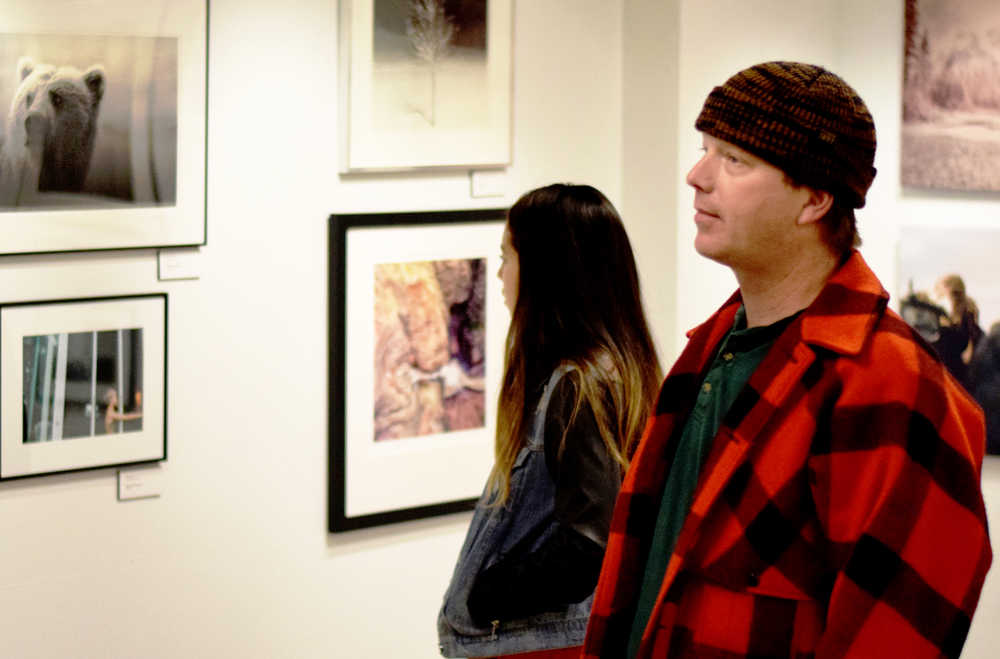Alaska is infested with photographers — for good reason, according to Kenai Peninsula College art professor Cam Choy.
“Obviously the state lends itself to the medium,” Choy said. “The vistas, the scenery, the landscape, the dramatic lighting that’s here. That’s certainly something that calls out the need for work like this.”
The work he referred to is the 49 photographs currently on the walls of the Kenai Fine Arts Center, comprising 2015’s Rarefied Light exhibit — an annual juried show traveling around the state, judged this year by photographer Susan Burnstine. Having already hung in Anchorage and Fairbanks, the photos will remain at the Kenai Fine Arts Center until Feb. 26.
Aside from being the work of Alaskan photographers — most from Anchorage, Eagle River, or Fairbanks — the collected images have little in common. Many are outdoor shots, ranging from Kaitlin Wilson’s best-in-show “House in the Birch Forest” — a highly composed black-and-white image in which a small white house appears through a screen of young birch trunks — to the plain and seemingly casual “Alaska Landscape #4” by Clark James Michler, featuring a bright landscape printed on the side of a tour vehicle as it follows a highway through a gloomier, richer real landscape. Others are interior scenes that make no apparent reference to Alaska. Some images are rendered artfully, such as “Husk” by Ellen Davis, a cyanotype printed on a cloth scroll of a woman in profile, shrouded by hair, superimposed with silhouettes of trees. Others lack obvious manipulation. Some are digital, others shot on film.
“The work stretches across a lot of different subjects,” Choy said. “Everything from landscapes to the human form to still life, and it’s such a rich mix. It’s definitely on par with previous exhibits.”
Choy named a black and white landscape — John R. DeLapp’s “Salton Sea,” featuring the eponymous water body located in California’s Coachella Valley — as one of his favorites. He praised the formal qualities of the work: the contrast between a highly textured pair of sharp-focused rocks in the foreground, and the white, misted water sitting vaguely behind them, blending with the sky.
Contrast also drew the praise of another viewer of the exhibit, Kenai Fine Arts Center board member Brandi Perly. She said one of her favorites was “Skin and Stone” by Greg Hansel. The contrast in that black and white image is between a woman’s obliquely stretched torso and the pair of stratified rocks flanking it. Perly described the image as “very texturally rich.”
“It has so many different textures and planes,” Perly said. “It’s soft and hard and angular all at the same time… It’s such a close-up shot, and because of the shadows and the light, you’re not entirely sure what you’re looking at at first.”
That uncertainty, Perly said, is another thing that interests her about an image.
“I like pictures that have a bit of mystery to them… You want to wonder about ‘what’s the story?’ What are you looking at? Why are you looking at it? What is the artist saying? Why is the artist saying it that way? Why is it black and white? What does that achieve? Asking all of these questions, you start to tell a story. Even if it’s not the story the artist intended, you start to tell a story.”
In previous years, the Rarefied Light exhibit has been hosted in Kenai Peninsula College’s Gary L. Freeburg gallery. This year it is at the Fine Art Center because the Freeburg gallery is being relocated and renovated. It is scheduled to reopen in the fall.
Reach Ben Boettger at ben.boettger@peninsulaclarion.com.

